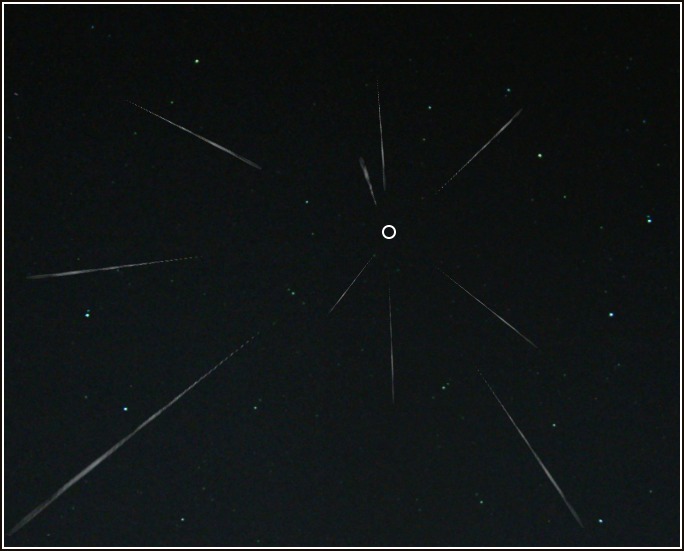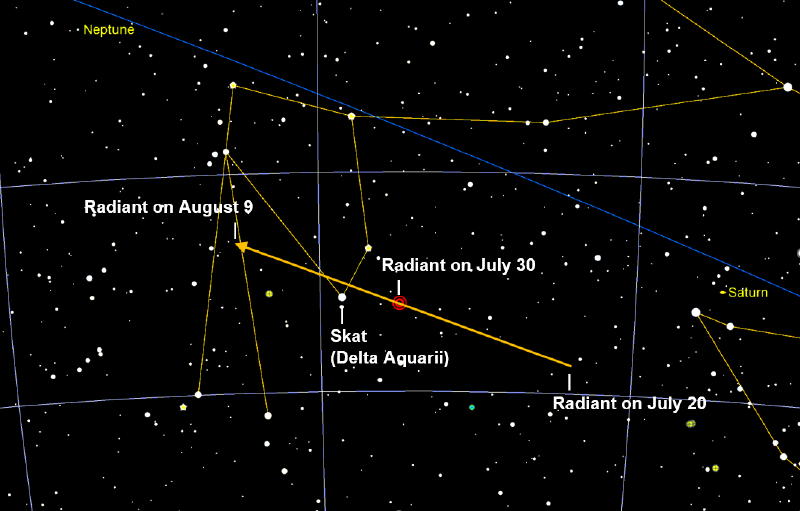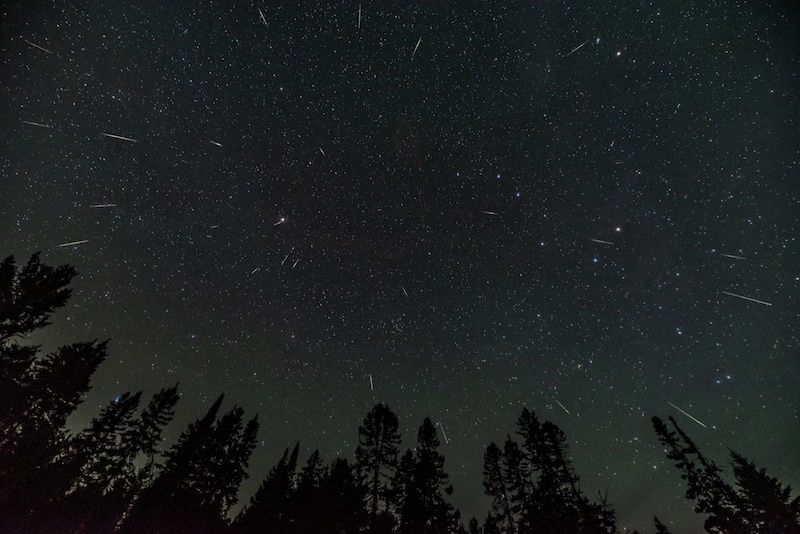
Meteor showers have a radiant point
Many times each year, when Earth passes through the orbital path of a comet, we see streaks in a dark night sky: a meteor shower! The meteors are cometary debris – icy, dusty particles, called meteoroids – vaporizing in Earth’s upper atmosphere. Often, you’ll hear astronomers speak of a meteor shower’s radiant point. And many people ask how to find a shower’s radiant point in the night sky.
What is the radiant point? Do you really need to find it to enjoy a meteor shower?
Fording the meteor stream
Let’s start with what it is. Remember, meteor showers happen as Earth moves through space, when we pass through the orbit of a comet. Comets are icy, dusty objects. And they litter their orbits with debris. The stream of cometary particles in space is called a meteor stream.
So crossing a meteor stream is much like crossing a fast-moving stream of water on Earth. The water (or comet dust) is all around you. You’re immersed in the water (or dust), but it’s striking you on only one side of your body, the side facing into the force of the moving water. Boom! The oncoming water might feel like a big hand trying to push you over. Once you continue moving across the stream, the direction and speed of the force changes, based upon the stream’s speed and direction and your speed and direction.
Hitting Earth on 1 side
Likewise, when Earth is fording a meteor stream in space, bits of comet dust are all around us. But they’re striking Earth only on one side, determined by a combination of the meteor stream’s speed and direction and Earth’s speed and direction. Most meteor showers occur after midnight, when Earth’s spin has turned into the oncoming meteor stream. Earth’s forward motion added to the meteors’ motion makes for some very swift meteors. But some showers, like the annual Draconids and Tau Herculids, approach the Earth from behind in our evening sky. Then the meteors have to catch up to us, resulting in slow meteors.
So – as you watch a meteor shower – you’re watching bits of dust strike Earth’s atmosphere on parallel paths, as illustrated below.

A 2nd analogy
Now imagine yourself on Earth looking up at the meteors. You can’t tell it just by looking at one meteor, but the meteors you see are indeed coming at you on parallel paths. And so we see the paths of the meteors converge at a single point in our sky: the radiant point. It’s like standing on railroad tracks and seeing the tracks converge in the distance. Do the tracks really converge? Nope. They stay parallel to one another and only appear to converge.
A meteor shower’s radiant point is much the same illusion as railroad tracks appearing to converge in the distance.
Of course, meteors have nothing whatever to do with railroad tracks. The meteors burn up some 60 miles (100 km) above Earth’s surface. The railroad tracks are right here on Earth. Caution: do not hang out at the railroad tracks thinking they will bring you more meteors. They won’t. Also, standing on railroad tracks is dangerous.

Hey! Who moved my railroad tracks?
The radiant point of meteor showers is fixed. Prepare to be shocked. Ok, ready?
The radiant moves.
This is a little-known fact. It’s surprising because we often see charts showing the location of radiant points with respect to this or that constellation. But those charts are set for the night of the shower’s peak.
You might be asking: Why hasn’t anyone told me this before? We don’t know! Many long-time meteor observers are surprised to hear this. It happens as Earth moves around the sun. A meteor shower radiant typically moves about 1 degree per day eastward, and approximately parallel to the ecliptic. A map showing the radiant shift of the Delta Aquariids meteor shower is below.

Tip: Don’t stare solely at the radiant
People always want to know how they can find meteor shower radiant points in the night sky. But when you watch a meteor shower, you shouldn’t be staring the whole time at the radiant. Most meteors don’t become visible until they’re some distance from the radiant. So when you’re watching a shower, try looking to the side of the radiant – about 45 degrees off – in all directions on the sky’s dome.
Tip: Know your radiant point rising times
Here’s something important about meteor shower radiant points. You’ll start seeing more meteors after the radiant rises into your sky. Most (but not all) meteor showers are best after midnight. That’s because their radiant points don’t rise until midnight or after. The rare and infrequent meteors you might see before the radiant rises will be Earth grazers, which start below your horizon and then trace long paths across your sky.
You’ll also see the most meteors when the radiant is highest in your sky. That’s why the Perseids, for example, are best just before dawn. The radiant for the Perseids rises in the middle of the night for everyone around the globe. And, for all of us, the Perseids’ radiant is highest before dawn. Then the meteors are raining down from the top of the sky. Awesome!
So, if you want to watch a meteor shower, find out what time the radiant point for that shower rises. You’ll see lots more meteors that way!

Tip: Watch for loooong meteors, far from the radiant
Here is one more thing. The meteor paths are generally longer the farther you look from the radiant. This is obvious in the image below. The shorter paths are near the radiant. If you see a short flash during a meteor shower, it is just a meteor headed in your direction. But don’t worry, the comet fluff does not make it to the ground.

The radiant point and meteor shower names
By the way, meteor shower radiant points are important for another reason. The shower typically takes its name from the constellation containing the radiant point during the time of the shower’s peak. When several meteor showers share the same constellation, then the closest star gets tagged for the name.
Draconids, Lyrids, Eta and Delta Aquariids, Perseids, Leonids, Geminids … You get the idea!
Bottom line: Meteors enter Earth’s atmosphere on parallel paths. So – just as when you stand on a railroad track, you see the tracks converge in the distance – you’ll see meteors appear to come from a single point in the sky: the radiant point!
Read about all the major meteor showers: EarthSky’s meteor shower guide











